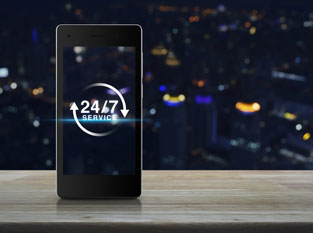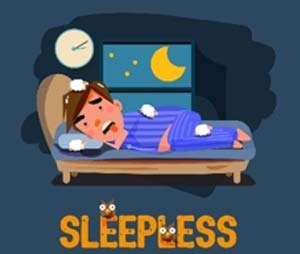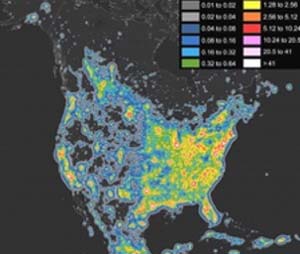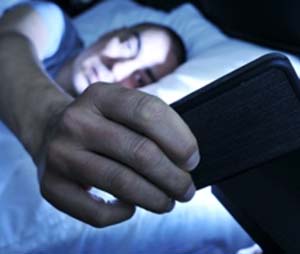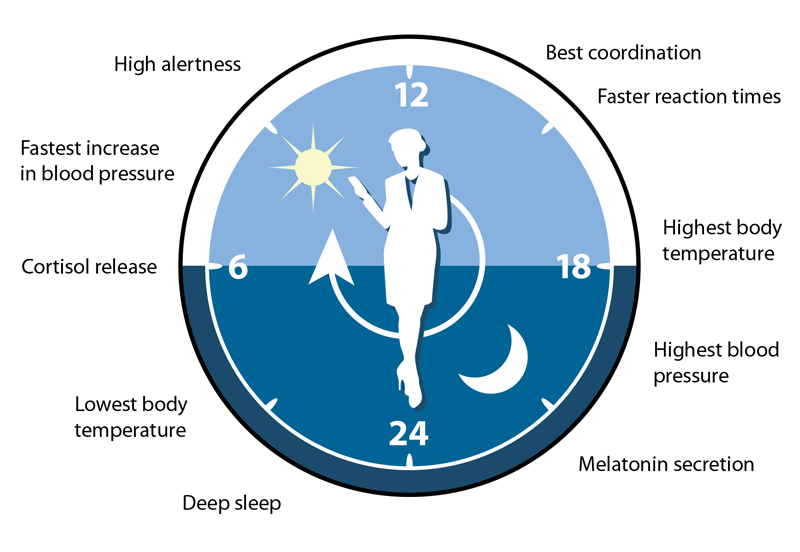NTP Review of Shift Work at Night, Light at Night, and Circadian Disruption
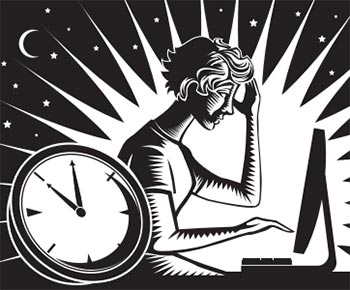
Topic Overview
Background Information
Modern electric lighting enables people to work, sleep, eat, and receive services throughout the 24-hour day. As a result, many individuals encounter new patterns and types of electrical light, change the timing of their meals, and experience sleep disturbances and other stresses. Those factors can disrupt circadian rhythms and possibly lead to adverse health effects such as cancer.
NTP studied two exposure scenarios related to modern lighting practices.
1. Night shift work
Night shift work is defined as working three hours between 12 and 5am. It is a complex exposure scenario and includes the following.
-
Extreme light at night (LAN)
-
Sleep disruption
-
Altered meal timing
-
Stress and behaviors
2. Sources of electrical light at night
-
Outdoor light
-
Self-luminous electronics
-
Light before bedtime or sleeping
Why is it important to study night shift work and light at night?
According to the Centers for Disease Control and Prevention, more than 10 million adults in the U.S. frequently work night shifts. Frequent night shift work is more common among men, blacks, and non-Hispanics.
Night shift work may contribute to almost 12,000 new breast cancer cases per year in the U.S. The link between night shift work and breast cancer among black women is a research gap.
Exposure to indoor electric lighting is nearly ubiquitous in our society. Findings from the National Sleep Foundation show that 90% of Americans use some type of electronic device a few nights per week within one hour of bedtime. In 2016, satellite imaging data of the Earth at night (see Figure 5) indicated that more than 99% of the U.S. population lived under light-polluted skies at night.
NTP Evaluation
NTP used systematic review methods and established criteria to reach its cancer hazard conclusions. These conclusions are based on scientific judgment with consideration given to all relevant information.
What did the evaluation find?
High confidence that persistent night shift work that disrupts circadian rhythms can cause breast cancer in women and may cause prostate cancer in men. Persistent night shift work is defined as frequent and long-term night shift work, especially beginning in early adulthood.
- The exact conditions of persistent night shift work are hard to define as duration and frequency may depend on their specific combination.
Moderate confidence for a causal relationship between human cancer and certain lighting conditions that cause circadian disruption. Certain lighting conditions are defined as excessive LAN exposure combined with insufficient daylight exposure.
- The lighting conditions at night that lead to circadian disruption depend on a combination of light characteristics such as wavelength, exposure duration, light intensity or levels, and timing.
FAQs
Q: How does circadian disruption work?
Sunlight is the major external signal that synchronizes the master circadian clock to natural light-dark cycles we experience daily. To keep biological rhythms coordinated (see figure for example of daily rhythms), the master clock, which is located in the brain, sends signals to a large network of peripheral clocks that are in almost every cell of the body. Exposure to too much light at night, especially during times when people are typically asleep, is thought to contribute to circadian disruption and increased risk of cancer.
Q: How were the conclusions on persistent night shift work and certain lighting conditions reached?
NTP used systematic review methods to identify studies, evaluate study quality, and integrate evidence across studies.
For each exposure scenario (night shift work or LAN), NTP integrated the evidence from human and non-human studies of exposure and cancer, studies of circadian disruption, and studies of mechanisms (e.g., biological effects) to reach our conclusions.
Using established criteria, we reached cancer hazard conclusions for each exposure scenario regarding the strength of the evidence from cancer epidemiology studies and for the overall conclusions. Conclusions were based on scientific judgment with consideration given to all relevant information. Subject-specific technical advisors served on a workshop panel to provide input on methods and scientific issues, and reviewed sections of the draft monograph.
An eight-member peer-review panel with discipline and subject-specific expertise concurred with NTP’s hazard conclusions for the two exposure scenarios that cause circadian disruption: (1) persistent night shift work and (2) certain light conditions.
Q: What evidence supports NTP hazard conclusions for persistent night shift work?
This conclusion is based on sufficient evidence of carcinogenicity from the collective body of evidence of cancer epidemiological studies in human populations and mechanistic studies in humans and in experimental animals.
Numerous epidemiology studies conducted in different geographical locations and among workers with different occupations provide evidence of increased breast cancer risk among night shift workers. The strongest evidence is for workers with “persistent” exposure, i.e., longer duration, higher frequency, and beginning night shift work at a younger age, when breast tissue may be more susceptible to environmental exposures.
The exact conditions of persistent night shift work are hard to define, as duration and frequency may depend on their specific combination. For example, an analysis of pooled data from five epidemiology studies found the highest risk of breast cancer among premenopausal women who worked at least 3 nights per week for at least 10 years. Another study found that younger women who worked night shifts at least three times a month for at least 20 years had more than a two-fold increased risk of developing breast cancer. Cancer risk may also depend on other factors such as the ability to adapt to shift work or traits that increase susceptibility to cancer.
Mechanistic studies demonstrate that circadian disruption plays a role in cancer development (e.g., human studies showing night shift workers suffer from circadian disruption, and animal and other studies showing that circadian disruption is linked to cancer). Animal studies also show that modeling shift work or jet lag by varying light-dark patterns over time promotes mammary gland and other types of cancer. Other studies show that night shift work can lead to the same type of biological effects in humans and animals that are typically induced by known carcinogens.
Q: What evidence supports NTP hazard conclusions for certain lighting conditions?
Studies in experimental animals showed that exposure to light at night can have multiple effects. Such exposure has been shown to cause circadian disruption (as evident by melatonin suppression and alterations in clock genes, for example) and promote proliferation and growth of tumors. Tumor growth is mediated by circadian disruption, among other factors. For example, some studies suggest that tumor promotion is mediated in part by decreased levels of the hormone melatonin; normal melatonin levels are important in preventing tumor growth. Light at night exposure in animal studies is also linked with other biological effects that are associated with cancer and can promote tumor growth.
In humans, exposure to light at night has also been shown to decrease nighttime melatonin levels.
Q: Are there ways to prevent cancer or death associated with these two exposure scenarios?
The National Institute for Occupational Safety and Health (NIOSH) offers several trainings and has prepared a science blog for people who work shift work and long hours, such as nurses or first responders. Additional information is also offered at the Occupational Safety and Health Administration’s website.
A recent international workshop of night shift work experts concluded that night shift work schedules that reduce circadian disruption may reduce breast cancer risk. They recommended that night shift schedules have no more than three consecutive night shifts, shift intervals of at least 11 hours, and shift duration of nine hours or less (Garde et al. 2020).
People using electronics in the evening may want to limit the use of bright screens before bedtime. There are also some apps that can reduce blue light from electronic devices during scheduled hours. Light that includes long wavelengths (red and orange in color) minimizes circadian disruption. Many devices have a night shift mode that reduces blue light emissions.
Documents
| Date | Document |
|---|---|
| Jan 19, 2012 | Federal Register notice requesting public comment on nominated substances |
| Apr 01, 2014 | Concept Document |
| May 07, 2018 | RoC Protocol |
| Aug 24, 2018 | Draft RoC Monograph |
| April 27, 2021 | NTP Cancer Hazard Assessment: Night Shift Work and Light at Night (Abstract) |
Meetings & Events
| Date | Event | Event Type | Materials |
|---|---|---|---|
| Jun 25, 2013 | NTP Board of Scientific Counselors Meeting |
Board of Scientific Counselors - BSC Meeting |
|
| Mar 10, 2016 | Workshop: Shift Work at Night, Artificial Light at Night, and Circadian Disruption |
Webinars & Workshops - RoC |
|
| Oct 05, 2018 | Peer Review of the Draft Report on Carcinogens Monograph on Night Shift Work and Light at Night |
Expert Panels - RoC |
|
Note on Accessibility: Persons with disabilities or using assistive technology may find some documents are not fully accessible. For assistance, email us or use our contact form and identify the documents/pages for which access is required. We will assist you in accessing the content of these files. NIEHS has helpful information on accessibility.


